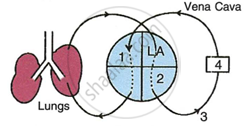Advertisements
Advertisements
प्रश्न
Label the diagram given below to show the four main parts of the urinary system and answer the following questions.

- Which organ removes extra salts and water from the blood?
- Where is the urine stored?
- What is the tube through which urine is excreted out of the body?
- What are the tubes that transfer urine from the kidneys to the urinary bladder called?
उत्तर

- The kidney removes extra salts and water from the blood.
- Urine is stored in the urinary bladder.
- Urine is excreted out of the body through the urethra.
- The ureter transfers urine from the kidneys to the urinary bladder.
APPEARS IN
संबंधित प्रश्न
Why is blood needed by all the parts of a body?
The diagram given below represents a section of the human heart. Answer the questions that follow :

(i) Which parts of heart are in the diastolic phase? Give a reason to support your answer.
(ii) Label the parts numbered 1 and 2 in the diagram. What type of blood flows through them?
(iii) What causes the heart sounds ‘LUBB’ and ‘DUP’?
(iv) Name the blood vessels that supply oxygenated blood to the heart muscles.
(v) Draw neat labelled diagrams of a cross section of an artery and a vein.
The exact location of the tricuspid valve
Given below is a diagram of a human blood smear.
Study the diagram and answer the questions that follow:

a) Name the components numbered ‘1’ to ‘4’
b) Mention two structural differences between the parts ‘1’ and ‘2’.
c) Name the soluble protein found in part ‘4’ which forms insoluble threads during clotting of blood.
d) What is the average lifespan of the component numbered ‘1’ ?
e) Component numbered ‘1’ do not have certain organelles but are very efficient in their function. Explain
what is Lymph nodes?
Find out my partner.
| Group 'A' | Group 'B' |
| 1. Heart beats | a. 350 ml |
| 2. RBC | b. 7.4 |
| 3. WBC | c. 37∘C |
| 4. Blood donation | d. 72 |
| 5. Normal body Temperature | e. 50-60 lakh/mm3 |
| 6. pH of oxygenated blood | f. 5000-6000 per mm3 |
Given below is a highly schematic diagram of the human blood circulatory system.
Which numbers represent the following respectively?
Aorta
Hepatic portal vein
Pulmonary artery
Superior vena cava
Renal vein
Stomach

During surgical operations or during accidents, the patient may be given blood from outside to save his life. What is the technical name of this process? Briefly explain the precautions to be taken in this process.
Name these:
Three components of circulatory system.
Given diagram is a schematic representation of the circulatory system in humans. Study the same and answer the questions that follow:
 |
- Label the parts 1 and 4 indicated in the diagram.
- Which of the above mentioned number is the thickest artery? Also write its name.
- Mention the number and chamber of the heart which has the thickest muscular wall.
- Which of the above numbers/structures has the maximum number of blood capillaries?
- Draw neat and labelled diagrams of the transverse section of vena cava and the part numbered as 3. Make sure to show the structural differences between these two in the diagram.
